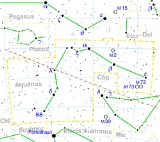
Lambda Aquarii
Encyclopedia
Lambda Aquarii (λ Aqr, λ Aquarii) is a star
in the constellation
Aquarius
. It has the obscure traditional names Hydor and Ekkhysis, from the ancient Greek
ὕδωρ "water" and ἔκχυσις "outpouring".
In Chinese
, , meaning Line of Ramparts
, refers to an asterism consisting of λ Aquarii, κ Capricorni
, ε Capricorni
, γ Capricorni
, δ Capricorni
, ι Aquarii
, σ Aquarii
, φ Aquarii
, 27 Piscium, 29 Piscium, 33 Piscium and 30 Piscium. Consequently, λ Aquarii itself is known as
Lambda Aquarii is a M-type
red giant
with a mean apparent magnitude
of +3.73. It is approximately 392 ly from Earth
. It is classified as an irregular
variable star
and its brightness varies from magnitude +3.70 to +3.80.
Star
A star is a massive, luminous sphere of plasma held together by gravity. At the end of its lifetime, a star can also contain a proportion of degenerate matter. The nearest star to Earth is the Sun, which is the source of most of the energy on Earth...
in the constellation
Constellation
In modern astronomy, a constellation is an internationally defined area of the celestial sphere. These areas are grouped around asterisms, patterns formed by prominent stars within apparent proximity to one another on Earth's night sky....
Aquarius
Aquarius (constellation)
Aquarius is a constellation of the zodiac, situated between Capricornus and Pisces. Its name is Latin for "water-bearer" or "cup-bearer", and its symbol is , a representation of water....
. It has the obscure traditional names Hydor and Ekkhysis, from the ancient Greek
Ancient Greek
Ancient Greek is the stage of the Greek language in the periods spanning the times c. 9th–6th centuries BC, , c. 5th–4th centuries BC , and the c. 3rd century BC – 6th century AD of ancient Greece and the ancient world; being predated in the 2nd millennium BC by Mycenaean Greek...
ὕδωρ "water" and ἔκχυσις "outpouring".
In Chinese
Chinese language
The Chinese language is a language or language family consisting of varieties which are mutually intelligible to varying degrees. Originally the indigenous languages spoken by the Han Chinese in China, it forms one of the branches of Sino-Tibetan family of languages...
, , meaning Line of Ramparts
Encampment (Chinese constellation)
The Encampment mansion is one of the Twenty-eight mansions of the Chinese constellations. It is one of the northern mansions of the Black Tortoise.-Asterisms:...
, refers to an asterism consisting of λ Aquarii, κ Capricorni
Kappa Capricorni
Kappa Capricorni is a star in the constellation Capricornus. κ Capricorni is a yellow G-type giant with an apparent magnitude of +4.72 and is approximately 291 light years from Earth....
, ε Capricorni
Epsilon Capricorni
Epsilon Capricorni is a triple star system in the constellation Capricornus. It also has the traditional star name Castra or Kastra, meaning "fort" or "military camp" in Latin...
, γ Capricorni
Gamma Capricorni
Gamma Capricorni is a giant star in the constellation Capricornus. It has the traditional name Nashira, which comes from the Arabic سعد ناشرة - sa'd nashirah for "the lucky one" or "bearer of good news"....
, δ Capricorni
Delta Capricorni
Delta Capricorni , also traditionally named Deneb Algedi and Scheddi, is a quaternary star system approximately 39 light-years away in the constellation of Capricornus . The primary star in the system is a white giant star and the combined light of its four members makes it the brightest "single"...
, ι Aquarii
Iota Aquarii
Iota Aquarii is a star in the constellation Aquarius.Iota Aquarii is a blue-white B-type subgiant with an apparent magnitude of +4.29. It is approximately 173 light years from Earth.-References:*...
, σ Aquarii
Sigma Aquarii
Sigma Aquarii is a double star in the constellation Aquarius. It is approximately 265 light years from Earth.Sigma Aquarii is an astrometric binary. The visible component is a white A-type subgiant with an apparent magnitude of +4.82. The orbital period of the binary is 654 days.-References:*...
, φ Aquarii
Phi Aquarii
Phi Aquarii is a star in the constellation Aquarius.Phi Aquarii is a M-type red giant with an apparent magnitude of +4.22. It is approximately 222 light years from Earth.-References:*...
, 27 Piscium, 29 Piscium, 33 Piscium and 30 Piscium. Consequently, λ Aquarii itself is known as
Lambda Aquarii is a M-type
Stellar classification
In astronomy, stellar classification is a classification of stars based on their spectral characteristics. The spectral class of a star is a designated class of a star describing the ionization of its chromosphere, what atomic excitations are most prominent in the light, giving an objective measure...
red giant
Red giant
A red giant is a luminous giant star of low or intermediate mass in a late phase of stellar evolution. The outer atmosphere is inflated and tenuous, making the radius immense and the surface temperature low, somewhere from 5,000 K and lower...
with a mean apparent magnitude
Apparent magnitude
The apparent magnitude of a celestial body is a measure of its brightness as seen by an observer on Earth, adjusted to the value it would have in the absence of the atmosphere...
of +3.73. It is approximately 392 ly from Earth
Earth
Earth is the third planet from the Sun, and the densest and fifth-largest of the eight planets in the Solar System. It is also the largest of the Solar System's four terrestrial planets...
. It is classified as an irregular
Irregular variable
An irregular variable is a type of variable star in which variations in brightness show no regular periodicity. There are two main sub-types of irregular variable: eruptive and pulsating.Eruptive irregular variables are divided into three categories:...
variable star
Variable star
A star is classified as variable if its apparent magnitude as seen from Earth changes over time, whether the changes are due to variations in the star's actual luminosity, or to variations in the amount of the star's light that is blocked from reaching Earth...
and its brightness varies from magnitude +3.70 to +3.80.

